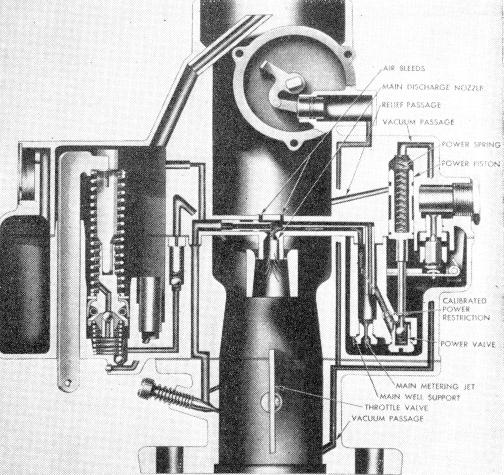POWER SYSTEM
As shown in Figure 4, a vacuum operated Power System is included in the carburetor to provide additional fuel for sustained high speed operation or increased road load power.
A direct manifold vacuum passage within the carburetor to the engine intake manifold operates this system. At any manifold vacuum above approximately 5" Hg., the power actuating piston is held in the "UP" position against the compression of the power spring by manifold vacuum. As a consequence, no fuel passes through the ball type power valve.
In accordance with the principle that any sudden acceleration causes a drop in intake manifold vacuum, the power spring has been calibrated so that at any vacuum below approximately 5" Hg., it forces the power actuating piston "DOWN".
The end of this piston then unseats the spring-loaded ball in the power valve. Fuel passes readily around the ball into the base of the Main Well Support. The calibrated power restriction meters the fuel prior to its joining the fuel from the main metering jet. Conversely as the manifold vacuum rises above approximately 5" Hg., the power piston is drawn immediately to the "UP" position, and the spring-loaded ball of the power valve closes, returning the carburetor to the economical part throttle mixtures. There is no adjustment required for the part throttle or Power Systems.
The relief passage which is drilled from the bore of the air horn into the power piston passage serves to relieve any vacuum built up around the piston diameter. This vacuum if unrelieved, would draw fuel past the piston and down the vacuum passage into the manifold resulting in an overly rich condition
Figure 4. Power System
